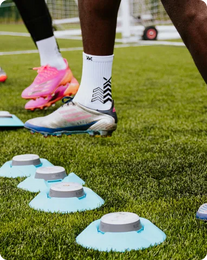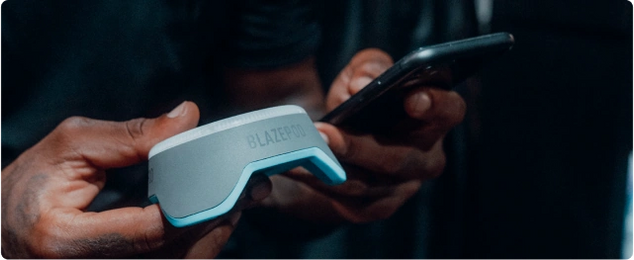Ever find yourself watching in awe as an athlete makes an impossible catch, deflects an unstoppable goal, or secures a split-second victory just when all hope is seemingly lost? Talent may get players noticed, but fast reaction times turn players into legends.
Uncover the secrets to developing lightning-fast intuition in your gameplay with these five proven techniques. From specific drills to mental strategies, learn how to train your reaction time for sports, gaming, and everyday life:

1. Focus on Dual Training
While studies into multitasking have suggested that it hinders our reaction time, research on dual training paints a different picture. By strategically combining physical and mental challenges, we can actually train our brains to react faster and become more adaptable.
By engaging in dual training, athletes, kids, and seniors alike can boost their brains’ wiring, speeding up information flow, multiplying neural connections, and, subsequently, creating faster reaction times.
When we encounter a familiar situation, the brain sends signals to the appropriate muscles more quickly and efficiently. This translates to faster movements, mental processing and quicker responses overall.
BlazePod's light-based training system capitalizes on this very concept. With a data-driven app, it merges physical and mental training through interactive lights. Users can perform drills responding to the light cues, which trains them to think faster, anticipate movements, and react quicker.

With consistent practice, BlazePod builds these skills simultaneously, making athletes more responsive overall. The app’s Benchmark feature even lets you compare how you stack up against the global BlazePod community.
2. Using Engaging Visual Stimuli
The sight of freshly baked cookies triggers a strong urge to reach out and grab one; this immediate response is a classic example of stimuli generating a reflexive response.
In the sport of track and field, where milliseconds matter, a runner’s training isn't just about raw speed. Half the training lies in perfecting the launch, that explosive burst of power triggered by the auditory cue. Countless hours are dedicated to honing this critical skill, transforming the gun’s bang into its trigger for acceleration. However, research suggests that reaction times are faster for visual than auditory stimuli.

With over 200 pre-designed drills and the freedom to customize your own, BlazePod goes beyond basic instincts; it’s a reflex training system. It concentrates on your ability to anticipate cues, observe your surroundings, and react decisively without a moment's hesitation.
If we can train our brains to convert visual stimuli into instinct, we can significantly speed up reaction time.
3. Simulating Gameplay in Practise
Many athletes dread the training grind. Traditional training often becomes predictable, leading to plateaus in reaction time improvement. There are only so many ways an athlete can do something without it becoming monotonous and dull.
Traditional drills often also focus exclusively on isolated movements, neglecting the crucial mental processing during live competition. Simulated gameplay, on the other hand, replicates the dynamic environment of actual gameplay.

Incorporating BlazePod’s cues that simulate game scenarios forces your brain to react and your body to move simultaneously, imitating the pressure and split-second decisions of real gameplay. Over time, simulated drills train your brain to process information faster, anticipate movements, and react quickly, giving you a leg up when the moment really counts.
Beyond the enjoyment of realistic sports experiences, simulated gameplay technology offers a surprising benefit: accessibility. BlazePod’s affordable, portable, and lightweight tool breaks down barriers for athletes lacking confidence, financial resources, or proximity to the necessary training facilities.
Don’t let tiresome exercises make you dread training; shake up any session with tools that improve performance, enhance situational awareness, and skyrocket your reaction time.
4. Adding the Element of Association
Just like slamming on the brakes at a red traffic light becomes second nature, athletes develop similar associations in sports.
Through association, athletes train their brains to see specific cues as triggers for automatic responses. This reduces reaction time by turning difficult and split-second decisions into reflexive behavior. The more an athlete trains their reactions for specific associations, the stronger the cues and triggers become, and the movements become second nature. In the same way, simulating gameplay allows athletes to prepare for any situation; associating specific movements with recognizable stimuli enables them to turn instinctive responses into precise gameplay.

By training your brain to associate cues with responses, it reduces the mental workload. This ‘mental shortcut’ of sorts frees up valuable energy for other critical aspects of the game, allowing you to react faster and stay sharper for longer.
Through light reaction training drills that target a vast array of skills for each sport, BlazePod trains your mind to recognize plays in the moment so you can react faster with pre-programmed techniques that you know will work. With BlazePod, you can train your mind to prepare for anything and focus on the things you can’t control when game time rolls around.
5. Hydrate, Sleep, Repeat
While drills and training are crucial, getting enough sleep and staying well-hydrated are equally important for peak reaction times. It may not be nearly as exciting as reaction light training technology, but it’s just as crucial.
One particular study revealed that participants who slept only 5 hours per night for a week experienced a significant decrease in reaction time compared to those who slept for 8 hours. For most sports requiring high energy and intense training, 9-10 hours of sleep may be the difference between having a fast reaction time and not making the cut.
Research has also shown that even mild dehydration can lead to a substantial decrease in reaction time. While athletes should drink plenty of water to make up for higher metabolic rates and more fluid loss for exercise, the average male should drink 15.5 cups of water (3.7 liters) and 11.5 cups (2.7 liters) for the average female. Naturally, there is no one-size-fits-all when it comes to how much water we should consume, but generally, adults don’t drink enough water. So, if you want to improve reaction time, get hydrating!
Conclusion
Even by improving your physique, running the fastest, or spending hours in the gym, athletic potential doesn’t rely on the physical alone. To be the best, an athlete must recognize patterns, react fast, and strike precisely. Don't just train your body hard; learn to train it right.























